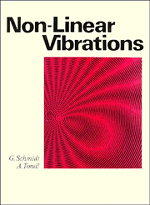Book contents
- Frontmatter
- Preface
- Contents
- Introduction
- 1 Basic properties and definitions
- 2 Methods of solution
- 3 Auxiliary curves for analysis of non-linear systems
- 4 Analysis in the phase plane
- 5 Forced, parametric and self-excited vibrations
- 6 Vibrations of systems with many degrees of freedom
- 7 Investigation of stability in the large
- 8 Analysis of some excited systems
- 9 Quenching of self-excited vibration
- 10 Vibration systems with narrow-band random excitation
- 11 Vibration systems with broad-band random excitation
- 12 Systems with autoparametric coupling
- Appendix
- Bibliography
- Index
Preface
Published online by Cambridge University Press: 10 May 2010
- Frontmatter
- Preface
- Contents
- Introduction
- 1 Basic properties and definitions
- 2 Methods of solution
- 3 Auxiliary curves for analysis of non-linear systems
- 4 Analysis in the phase plane
- 5 Forced, parametric and self-excited vibrations
- 6 Vibrations of systems with many degrees of freedom
- 7 Investigation of stability in the large
- 8 Analysis of some excited systems
- 9 Quenching of self-excited vibration
- 10 Vibration systems with narrow-band random excitation
- 11 Vibration systems with broad-band random excitation
- 12 Systems with autoparametric coupling
- Appendix
- Bibliography
- Index
Summary
It has not been an easy decision to choose the general title of Non-linear vibrations. Recently there has been an overwhelming development of the theory and many applications of non-linear vibrations, development reflected in numerous books, many specialist journals and the Equa-Diff conferences and ten International Conferences on Non-linear Oscillations.
In view of these development, we would like this book to be considered not as an attempt to survey the state of the art and extent of current knowledge of non-linear vibrations, but rather as an account of some methods and results in the field of non-linear vibrations we have obtained or encountered in our personal experience. We do not believe in a single, comprehensive theory of non-linear vibrations, not even in the sense of linear vibration theory. On the contrary, we see the specific difficulty – and the attraction – of non-linear vibrations in the non-existence, more than in the existence, of certain rules of order. The nature of our endeavour may perhaps best be conveyed in Rilke's words: Uns überfüllts. Wir ordnens. Es zerfällt. Wir ordnens wieder…'.
We believe that the material presented here can be used for many kinds of vibration problems, although translating it into their terms is no simple task. Various methods and examples are traditionally associated with different notations, and we have not tried to make the notation uniform throughout this book.
The first author is responsible in particular for chapters 5, 6, 10, 11 and 12, the second for chapters 3, 4, 7, 8 and 9.
- Type
- Chapter
- Information
- Non-linear Vibrations , pp. 5 - 6Publisher: Cambridge University PressPrint publication year: 1986



